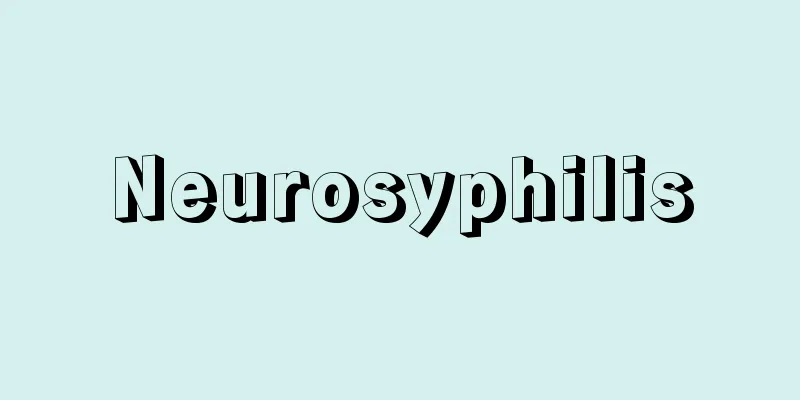Neurosyphilis

|
(1) Neurosyphilis Concept Neurosyphilis is a neurological disorder caused by the direct invasion of the nervous system by Treponema pallidum (TP), a type of spirochete. It is characterized by a wide variety of clinical symptoms, as shown in Table 15-7-6, and meningovascular neurosyphilis is the most frequently diagnosed form of neurosyphilis. It is also important to note that in recent years, a number of patients have developed atypical symptoms due to inadequate treatment. Pathological TP usually invades the nervous system within 3 to 18 months after infection. It is said that TP invades the central nervous system in 25 to 60% of patients during the early syphilis stage (primary and secondary syphilis). In the early stages, mononuclear cell infiltration is seen in the meninges, and if this inflammatory reaction spreads to the brain parenchyma, axonal degeneration occurs. If it spreads to the meningeal arterioles, it causes endarteritis characteristic of syphilis, leading to occlusion of the intima, and further to infarction and demyelination of the brain and spinal cord. In late syphilis (tertiary syphilis), the clinical course of progressive paralysis is extremely slow. Pathologically, after the inflammatory reaction of the meninges, infiltration of lymphocytes and plasma cells is seen in the cortical small blood vessels, which spreads to the cortical parenchyma. This causes the degeneration and loss of cortical neurons and the proliferation of glial cells. Macroscopically, the brain shows significant atrophy. The ventricles are enlarged, and their walls are covered with sand-like granulations, known as granular ependymitis. In a different form of tabes dorsalis, inflammation of the meningeal blood vessels is followed by degeneration of the dorsal roots and columns of the spinal cord. Clinical manifestations 1) Asymptomatic neurosyphilis: Syphilis reactions in serum and cerebrospinal fluid are positive, and cerebrospinal fluid findings usually show lymphocytic pleocytosis of less than 100/μL and protein of less than 100 mg/dL. 2) Meningeal and vascular neurosyphilis: Meningeal neurosyphilis develops 1 to 2 years after infection. Clinical symptoms include headache, neck stiffness, cranial nerve damage, convulsions, and changes in mental status. The most common cranial nerves affected are II, VII, and VIII, and patients experience visual impairment, hearing loss, tinnitus, and facial nerve paralysis. Meningeal vascular neurosyphilis typically develops 6 to 7 years after infection with syphilis. It is characterized by widespread inflammation of the meninges and focal or widespread cerebral arterial damage to the small, medium, and large vascular systems. It is characterized by cerebral infarction in the territory of the middle cerebral artery in young adults. Spinal cord infarction is rarely a complication. The cerebrospinal fluid cell count is 10 to 100/μL, mainly lymphocytes, and the protein level is approximately 100 to 200 mg/dL. 3) Progressive paralysis (paretic neurosyphilis): Now that antibiotics are widely available, the onset of progressive paralysis is rare, but it typically occurs 15 to 20 years or more after syphilis infection. Clinically, the main symptom is psychiatric symptoms, with onset being abnormal behavior and irritability, and gradually patients develop memory impairment and impaired judgment. Patients also exhibit Argyll Robertson pupil (ARP), which is characteristic of neurosyphilis. In ARP, the pupils tend to shrink and become irregular, and the light reflex is lost, but the near reflex is preserved. The name progressive paralysis comes from the fact that in the terminal stages, quadriplegia occurs. 4) Tabes dorsalis: Tabes dorsalis presents with demyelinating damage to the posterior columns and damage involving the dorsal roots and dorsal root ganglia. It develops 15 to 20 years after syphilis infection, and the main symptoms are lancinating pain, ataxic gait disturbance, urinary incontinence, impotence, loss of tendon reflexes, and positive Romberg sign. Lancinating pain is a short-lived, intense pain that occurs mainly in the lower limbs and is seen in 80 to 90% of cases of tabes dorsalis. In addition, pupil abnormalities are seen in more than 90% of cases, half of which are ARP. Other symptoms include optic nerve atrophy, Charcot joints due to nutritional disorders, visceral crisis, and Abadie sign, in which no pain is felt even when the Achilles tendon is squeezed tightly. Cerebrospinal fluid findings and syphilis reactions Syphilis reactions include the serologic test for syphilis (STS) method, which uses lipid antigens such as the RPR method, glass plate method, and agglutination method, the indirect hemagglutination test (Treponema pallidum hemagglutination: TPHA) using syphilis spirochetes, and the fluorescent treponema antibody absorption test (FTA-ABS). STS is a sensitive indicator of treatment, but biological false positives can occur. FTA-ABS is sensitive and highly specific. STS has a low positive rate in late syphilis, and TPHA in early syphilis, so STS and TPHA are performed as screening tests, and if either one is positive, FTA-ABS is confirmed as necessary. Treatment Asymptomatic cases are treated in the same way as symptomatic cases. The first choice is water-soluble penicillin G, administered intravenously at a total of 18 to 24 million units per day for 10 to 14 days. In patients with penicillin allergies, ceftriaxone may be administered as an alternative treatment, but this is not recommended; it is recommended that water-soluble penicillin G be administered after desensitization. In the early stages of penicillin treatment, the Jarisch-Herxheimer reaction can cause fever and chills. [Tsugawa Jun, Tsuboi Yoshio] Classification of neurosyphilis Table 15-7-6 Source : Internal Medicine, 10th Edition About Internal Medicine, 10th Edition Information |
|
(1)神経梅毒(neurosyphilis) 概念 神経梅毒とは,スピロヘータの一種であるTreponema pallidum(TP)が神経系へ直接浸潤することにより引き起こされる神経障害である.表15-7-6のように,多彩な臨床症候を示すことが特徴で,なかでも髄膜血管型神経梅毒は神経梅毒の病型で最も高頻度に診断されている.また,近年,不十分な治療により,非典型的な症状を呈する患者も少なくないことに注意する必要がある. 病理 TPは,通常,感染後3~18カ月以内に神経系に侵入する.早期梅毒(第1期梅毒,第2期梅毒)の時期に25~60%の患者でTPの中枢神経系への浸潤が起きるとされている.初期には髄膜に単核球の浸潤がみられ,この炎症反応が脳実質に及ぶと軸索変性をきたす.さらに髄膜の細動脈に及ぶと梅毒に特徴的な動脈内膜炎を起こし,内膜の閉塞,さらには脳や脊髄の梗塞,脱髄などが発症する.晩期梅毒(第3期梅毒)のなかで進行麻痺の臨床経過はきわめて緩徐である.病理学的には髄膜の炎症反応の後,皮質細血管にリンパ球や形質細胞の浸潤がみられ,それは皮質実質にも波及する.このため皮質神経細胞の変性消失,グリア細胞の増生が起こる.肉眼的にも脳は萎縮が顕著である.脳室は拡大し,その壁面は顆粒状上衣炎とよばれるように砂状の肉芽がみられる.異なる病型の脊髄癆では,髄膜血管の炎症の後,脊髄の後根や後索の変性が起こる. 臨床症状 1)無症候性神経梅毒(asymptomatic neurosyphilis): 血清,髄液中の梅毒反応が陽性で,髄液所見は,細胞増多はリンパ球主体で100 /μL未満,蛋白は100 mg/dL未満が通常である. 2)髄膜血管型神経梅毒(meningeal and vascular neurosyphilis): 髄膜型神経梅毒は,感染後1~2年で発症する.臨床症候は,頭痛,項部硬直,脳神経障害,痙攣および精神状態の変化をきたす.障害される脳神経は,Ⅱ,ⅦおよびⅧが多く,視力障害,聴力低下,耳鳴りおよび顔面神経麻痺を呈する.髄膜血管型神経梅毒は,典型的には梅毒に感染後6~7年後に発症する.特徴は髄膜の広範な炎症と,局所的または広範な,小,中,大血管系の脳動脈障害である.若年成人の中大脳動脈領域の脳梗塞が特徴である.まれに脊髄梗塞を合併する.髄液細胞数はリンパ球主体で10~100/μL,蛋白は100~200 mg/dL程度である. 3)進行麻痺(paretic neurosyphilis): 抗菌薬が普及した現在では進行麻痺の発症はまれであるが,典型的には梅毒の感染から15~20年以上経過した後に発症する.臨床的に精神症状が主体で,立ち振る舞いの異常,易怒性などで発症し,徐々に記憶障害や判断力の低下を呈する.また,神経梅毒に特徴的なArgyll Robertson瞳孔(ARP)を呈する.ARPは,瞳孔は縮小傾向で辺縁不整となり,対光反射は消失するが,近見反射は保たれる.進行麻痺の名称は末期には四肢麻痺を呈することに由来する. 4)脊髄癆(tabes dorsalis): 脊髄癆は,後索の脱髄性障害や後根および後根神経節を含む障害を呈する.梅毒の感染から15~20年経過した後に発症し,主症状は,電撃痛,失調性の歩行障害,尿失禁,インポテンツ,腱反射の消失,Romberg徴候陽性などである.電撃痛は,おもに下肢に生じる短時間の激しい疼痛で,脊髄癆の80~90%に認める.また,90%以上に瞳孔異常を認め,その半数はARPである.その他,視神経萎縮,栄養障害によるCharcot関節,内臓クリーゼ,アキレス腱を強く握っても痛みを感じないAbadie徴候などがみられる. 髄液所見・梅毒反応 梅毒反応には,RPR法,ガラス板法,凝集法など脂質抗原を用いるSTS法(serologic test for syphilis)と梅毒スピロヘータを用いる間接赤血球凝集反応 (Treponema pallidum hemagglutination:TPHA)や蛍光トレポネーマ抗体吸収反応(fluorescent treponema antibody absorption:FTA-ABS)などがある.治療の指標にはSTSが鋭敏であるが,生物学的偽陽性がみられる.FTA-ABSは鋭敏かつ特異度が高い.STSは後期梅毒に,TPHAは初期梅毒に陽性率が低いため,STSとTPHAをスクリーニングとして行い,いずれか一方が陽性であれば必要に応じてFTA-ABSを確認する. 治療 無症候性でも症候性と同様に治療を行う.第一選択は水溶性ペニシリンGで,1日総量1800~2400万単位の点滴静注を10~14日間行う.ペニシリンアレルギーの患者では代替療法としてセフトリアキソンを投与する場合があるが推奨されておらず,脱感作を行ったうえで水溶性ペニシリンGを投与することが推奨されている.ペニシリン治療の初期に発熱,悪寒などを起こすJarisch-Herxheimer反応がある.[津川 潤・坪井義夫] 神経梅毒の分類"> 表15-7-6 出典 内科学 第10版内科学 第10版について 情報 |
<<: Neurodermatitis - Neurodermatitis
Recommend
Camptostoma
…Nests vary according to species and habitat. Mos...
Yoshihisa Kuzu
1874-1958 A nationalist from the Meiji to Showa e...
Houphouet-Boigny, F.
…An African political party formed in colonial Fr...
supraindividual
... This is one way of thinking, but in the case ...
Kegonji Temple
[1] A temple in Jirisan, Gurye County, South Jeoll...
Oki Electric Industry Co., Ltd.
A major communications equipment manufacturer esta...
Salamander - Fire salamander
An animal of the family Salamandridae in the orde...
Orientalistik (Germany)
A general term for the study of the languages, his...
Ichiinsei - Ichiinsei
…It is also called “the birth of one yang” becaus...
Unzen azalea - Unzen azalea
An evergreen shrub of the Ericaceae family (APG c...
Abi-Raunken - Abi-Raunken
...Therefore, an incantation with an unclear mean...
Bufo torrenticola (English spelling)
…Toad [Takahiro Matsui]. … *Some of the terminolo...
field mustard
...The latter three species are plants that arose...
Arima Seminario - Arima Seminario
...It is located in the southern part of the Shim...
Lost items - Otoshimono
Money or valuables that have been carelessly dropp...









![Yubiso [Hot Spring] - Yubiso](/upload/images/67cd150a874a7.webp)